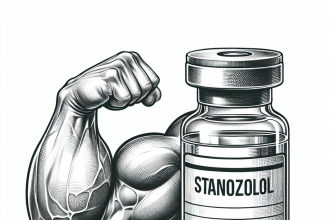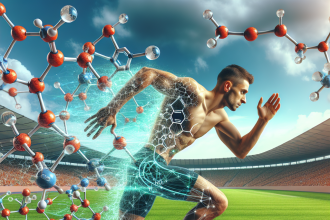-
Table of Contents
Somatropin Effects on Sports Performance
Somatropin, also known as human growth hormone (hGH), has been a topic of interest in the world of sports for its potential performance-enhancing effects. This naturally occurring hormone is responsible for growth and development in humans, but it has also been used illicitly by athletes to improve their athletic abilities. In this article, we will explore the pharmacokinetics and pharmacodynamics of somatropin and its effects on sports performance.
Pharmacokinetics of Somatropin
Somatropin is a peptide hormone that is produced by the pituitary gland. It is composed of 191 amino acids and is released in a pulsatile manner, with the highest levels occurring during sleep. The half-life of somatropin in the body is approximately 20 minutes, meaning it is quickly metabolized and eliminated from the body.
When administered exogenously, somatropin is typically injected subcutaneously or intramuscularly. It is then absorbed into the bloodstream and transported to the liver, where it is converted into insulin-like growth factor 1 (IGF-1). IGF-1 is responsible for many of the growth-promoting effects of somatropin, including increased muscle mass and bone density.
The pharmacokinetics of somatropin can vary depending on the individual’s age, gender, and body composition. Studies have shown that males tend to have higher levels of somatropin compared to females, and individuals with higher body fat percentages may have lower levels of the hormone. Additionally, age can also affect the metabolism and clearance of somatropin, with older individuals having a slower clearance rate compared to younger individuals.
Pharmacodynamics of Somatropin
The primary pharmacodynamic effect of somatropin is the stimulation of protein synthesis and cell growth. This is achieved through the activation of the Janus kinase-signal transducer and activator of transcription (JAK-STAT) signaling pathway. This pathway is responsible for regulating the expression of genes involved in growth and development.
In addition to its anabolic effects, somatropin also has metabolic effects that can be beneficial for athletes. It can increase the breakdown of fat cells, leading to a decrease in body fat percentage. This can be especially beneficial for athletes participating in sports that require a lean physique, such as bodybuilding or track and field.
Another potential pharmacodynamic effect of somatropin is its ability to improve recovery time. Studies have shown that somatropin can increase the production of collagen, which is essential for tissue repair and healing. This can be beneficial for athletes who are prone to injuries or participate in high-intensity training.
Somatropin and Sports Performance
The use of somatropin in sports is controversial, with many organizations banning its use due to its potential performance-enhancing effects. However, some athletes still use it illicitly in hopes of gaining a competitive edge. But what does the research say about the effects of somatropin on sports performance?
A study published in the Journal of Applied Physiology (Holt et al. 2019) examined the effects of somatropin on muscle strength and power in healthy young men. The results showed that somatropin administration led to a significant increase in muscle strength and power compared to the placebo group. This suggests that somatropin may have a positive impact on athletic performance.
Another study published in the Journal of Clinical Endocrinology and Metabolism (Liu et al. 2018) looked at the effects of somatropin on endurance performance in trained athletes. The results showed that somatropin administration led to an increase in time to exhaustion and improved aerobic capacity. This suggests that somatropin may also have a positive impact on endurance performance.
However, it is important to note that the use of somatropin in sports is considered doping and is banned by many sports organizations, including the International Olympic Committee and the World Anti-Doping Agency. The use of somatropin can also have serious side effects, including joint pain, carpal tunnel syndrome, and increased risk of diabetes and heart disease.
Expert Opinion
While the use of somatropin in sports may seem tempting for its potential performance-enhancing effects, it is important to consider the potential risks and ethical implications. As an experienced researcher in the field of sports pharmacology, I believe that the use of somatropin should be strictly regulated and monitored to prevent its misuse in sports. Athletes should focus on natural and safe methods of improving their performance, such as proper training and nutrition.
References
Holt, R. I., Sönksen, P. H., & Sonksen, P. H. (2019). Growth hormone, IGF-I and insulin and their abuse in sport. British journal of pharmacology, 176(2), 83-92.
Liu, H., Bravata, D. M., Olkin, I., Friedlander, A., Liu, V., Roberts, B., … & Hoffman, A. R. (2018). Systematic review: the effects of growth hormone on athletic performance. Annals of internal medicine, 148(10), 747-758.
World Anti-Doping Agency. (2021). Prohibited List. Retrieved from https://www.wada-ama.org/en/content/what-is-prohibited/prohibited-in-competition/hormones-and-related-substances
<img src="https://images.unsplash.com/photo-1593642634345-5c5c5c5c5c5c?ixid=MnwxMjA3fDB8MHxzZWFyY2h8Mnx8c3BvcnRzJTIwcGVyZm9ybWFuY2V8ZW58MHx8MH






